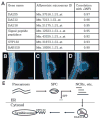A nodule-specific protein secretory pathway required for nitrogen-fixing symbiosis
- PMID: 20185723
- PMCID: PMC4824053
- DOI: 10.1126/science.1184096
A nodule-specific protein secretory pathway required for nitrogen-fixing symbiosis
Abstract
The nitrogen-fixing symbiosis between Sinorhizobium meliloti and its leguminous host plant Medicago truncatula occurs in a specialized root organ called the nodule. Bacteria that are released into plant cells are surrounded by a unique plant membrane compartment termed a symbiosome. We found that in the symbiosis-defective dnf1 mutant of M. truncatula, bacteroid and symbiosome development are blocked. We identified the DNF1 gene as encoding a subunit of a signal peptidase complex that is highly expressed in nodules. By analyzing data from whole-genome expression analysis, we propose that correct symbiosome development in M. truncatula requires the orderly secretion of protein constituents through coordinated up-regulation of a nodule-specific pathway exemplified by DNF1.
Figures





Similar articles
-
The C2H2 transcription factor regulator of symbiosome differentiation represses transcription of the secretory pathway gene VAMP721a and promotes symbiosome development in Medicago truncatula.Plant Cell. 2013 Sep;25(9):3584-601. doi: 10.1105/tpc.113.114017. Epub 2013 Sep 30. Plant Cell. 2013. PMID: 24082011 Free PMC article.
-
Transcription of ENOD8 in Medicago truncatula nodules directs ENOD8 esterase to developing and mature symbiosomes.Mol Plant Microbe Interact. 2008 Apr;21(4):404-10. doi: 10.1094/MPMI-21-4-0404. Mol Plant Microbe Interact. 2008. PMID: 18321186
-
Plant peptides govern terminal differentiation of bacteria in symbiosis.Science. 2010 Feb 26;327(5969):1122-6. doi: 10.1126/science.1184057. Science. 2010. PMID: 20185722
-
How rhizobial symbionts invade plants: the Sinorhizobium-Medicago model.Nat Rev Microbiol. 2007 Aug;5(8):619-33. doi: 10.1038/nrmicro1705. Nat Rev Microbiol. 2007. PMID: 17632573 Free PMC article. Review.
-
The Multiple Faces of the Medicago-Sinorhizobium Symbiosis.Methods Mol Biol. 2018;1822:241-260. doi: 10.1007/978-1-4939-8633-0_16. Methods Mol Biol. 2018. PMID: 30043308 Review.
Cited by
-
The Sinorhizobium meliloti SyrM regulon: effects on global gene expression are mediated by syrA and nodD3.J Bacteriol. 2015 May;197(10):1792-806. doi: 10.1128/JB.02626-14. Epub 2015 Mar 16. J Bacteriol. 2015. PMID: 25777671 Free PMC article.
-
Elevated CO(2) modifies N acquisition of Medicago truncatula by enhancing N fixation and reducing nitrate uptake from soil.PLoS One. 2013 Dec 5;8(12):e81373. doi: 10.1371/journal.pone.0081373. eCollection 2013. PLoS One. 2013. PMID: 24339920 Free PMC article.
-
Transcription reprogramming during root nodule development in Medicago truncatula.PLoS One. 2011 Jan 27;6(1):e16463. doi: 10.1371/journal.pone.0016463. PLoS One. 2011. PMID: 21304580 Free PMC article.
-
Genetic and Molecular Mechanisms Underlying Symbiotic Specificity in Legume-Rhizobium Interactions.Front Plant Sci. 2018 Mar 9;9:313. doi: 10.3389/fpls.2018.00313. eCollection 2018. Front Plant Sci. 2018. PMID: 29593768 Free PMC article. Review.
-
Exploring the role of symbiotic modifier peptidases in the legume - rhizobium symbiosis.Arch Microbiol. 2024 Mar 11;206(4):147. doi: 10.1007/s00203-024-03920-w. Arch Microbiol. 2024. PMID: 38462552 Review.
References
-
- Thompson AR, Vierstra RD. Curr Opin Plant Biol. 2005;8:165. - PubMed
Publication types
MeSH terms
Substances
Grants and funding
LinkOut - more resources
Full Text Sources
Other Literature Sources

